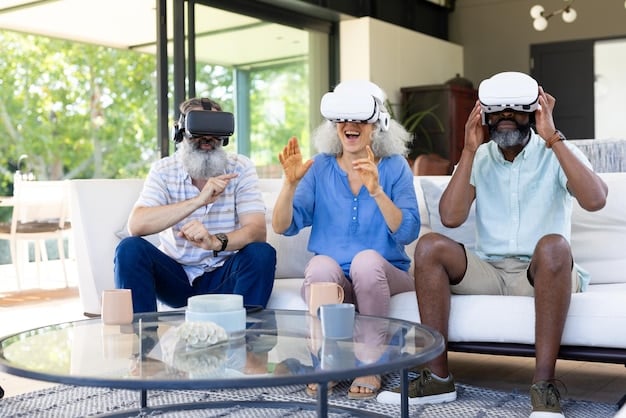Haptic Feedback Suits: Are They Worth the $2,000 Price Tag?

Haptic feedback suits, ranging from consumer-grade vests to full-body systems, deliver immersive tactile sensations for gaming and VR by simulating in-game actions, with their $2,000 price tag reflecting advanced technology, material science, and their potential to redefine digital interaction.
In the evolving landscape of gaming and virtual reality, immersion is the ultimate quest. For years, rumble controllers were the pinnacle of tactile feedback, but a new contender has emerged: the haptic feedback suit. These remarkable devices promise to translate on-screen action into physical sensations, blurring the lines between the digital and the real. But with a significant entry barrier, particularly the **New Haptic Feedback Suits: Are They Worth the $2,000 Price Tag?** and what do they truly offer that justifies such an investment?
The Dawn of Tactile Immersion: Understanding Haptic Technology
Haptic technology, at its core, refers to any technology that can simulate the sense of touch. While vibration motors in game controllers are a basic form of haptics, modern haptic feedback suits elevate this concept dramatically. These suits integrate a network of actuators, motors, and sometimes even localized heating/cooling elements to create a range of sensations across the user’s body. The goal is to make virtual experiences feel tangible, from the recoil of a weapon to the impact of a punch or the gentle brush of wind.
The progression from simple rumble to full-body suits is a testament to the industry’s drive for deeper immersion. Early haptic vests offered basic chest-level feedback, often limited to vibrating in response to explosions or bullet hits. Today’s suits boast dozens of individual haptic points, allowing for directional feedback and a wider variety of nuanced sensations. This evolution is not merely about adding more vibrations; it’s about refining the fidelity and spatial accuracy of the tactile experience, offering a truly transformative layer to digital interactions.
How Haptic Suits Work
The operational mechanics of haptic suits involve several key components working in concert. Fundamentally, software within a game or VR application sends data corresponding to in-game events to the suit. This data is then translated into specific commands for the suit’s various actuators. These actuators can be small eccentric rotating mass (ERM) motors, linear resonant actuators (LRAs), or even more advanced technologies like electroactive polymers or pneumatic systems, each designed to produce different types of tactile effects.
The complexity scales rapidly with the desired level of immersion. A simple vest might use a few large ERM motors, while a full-body suit could employ over a hundred micro-actuators strategically placed to simulate precise impacts or textures. Powering these systems, ensuring low latency, and managing thermal dissipation are significant engineering challenges that contribute to the overall cost and sophistication of the device.
- Actuators: Small devices that convert electrical energy into kinetic energy, creating vibrations or pressures.
- Sensors: Some advanced suits include motion tracking or pressure sensors to enhance interactions.
- Software Integration: Crucial for translating in-game events into precise haptic feedback signals.
- Connectivity: Often wireless (Bluetooth, Wi-Fi) to allow for untethered movement.
The design philosophy behind high-end haptic suits emphasizes realism and precision. It’s not just about feeling something; it’s about feeling the right thing, in the right place, at the right time. This requires a sophisticated mapping of virtual events to physical sensations, an area where developers and hardware manufacturers are continually innovating to improve the user experience. The ambition is to create a seamless extension of the digital world onto the wearer’s skin, making virtual encounters profoundly real.
Key Players and Product Landscape in 2025
As of 2025, the haptic feedback suit market has matured beyond its nascent stages, with several companies vying for market dominance. While smaller startups continue to innovate, certain brands have established themselves as frontrunners, often setting the benchmark for performance, comfort, and, ultimately, price. These companies range from those focusing on consumer-grade products to those developing professional-grade solutions for military training or rehabilitation. However, for the average gamer or VR enthusiast, the primary focus remains on devices that balance performance with accessibility.
The consumer market primarily sees competition among a few key players, each with their unique approach to haptic delivery. Some specialize in modular systems, allowing users to purchase core vests and then expand with arm or leg modules. Others offer complete, all-in-one solutions designed for maximum immersion out of the box. This diversity reflects the varied demands of the market, from casual users seeking a bit of enhanced immersion to hardcore enthusiasts craving an unparalleled sensory experience.
Notable Brands and Their Offerings
The landscape includes well-known names and emerging innovators. Bhaptics, for instance, has gained considerable traction with its TactSuit series, offering modular vests and arm/foot accessories that are widely supported by game developers. Their approach focuses on a balance of affordability and effective haptic feedback, making them a popular choice for many. Another significant player is Teslasuit, which targets a more professional market with full-body suits that include not only haptic feedback but also biometric data tracking and climate control, pushing the boundaries of what these suits can achieve.
For gamers, the appeal often lies in a system that offers broad compatibility and a tangible improvement to gameplay. Beyond simply feeling impacts, some suits are beginning to incorporate more subtle feedback, such as the sensation of rain, the warmth of fire, or the chill of a cold environment. These nuanced additions are what truly differentiate high-end suits and contribute to their higher price points, as they require more sophisticated actuators and precise control systems.
- Bhaptics TactSuit: Known for modularity and extensive game support, catering to a broad gaming audience.
- Teslasuit: A more premium, professional-grade option with advanced features like biometrics and climate control.
- HaptX Gloves: While not a full suit, these gloves are pioneers in ultra-realistic haptic feedback for hands, illustrating the potential for localized high-fidelity haptics.
- Future Innovations: Research is ongoing into more compact, lightweight, and versatile haptic materials.
The variety of products signifies a healthy, competitive market where innovation is constant. Each brand attempts to carve out its niche by emphasizing different aspects, whether it’s comfort, durability, the fidelity of the haptic effects, or the breadth of supported content. The $2,000 price point often sits in the mid-to-high range of consumer-focused offerings, representing a significant commitment from the buyer but also delivering a more comprehensive and advanced experience than entry-level options.
The $2,000 Question: What Drives the Cost?
The asking price of approximately $2,000 for a significant haptic feedback suit might seem steep to many, especially when compared to traditional gaming peripherals. However, understanding the underlying factors that contribute to this cost reveals a complex interplay of cutting-edge technology, specialized materials, research and development, and the relatively niche market they currently serve. This isn’t just a simple peripheral; it’s a wearable piece of advanced engineering designed to manipulate one of our fundamental senses.
One primary driver of cost is the sheer number and complexity of the haptic actuators themselves. Unlike a simple rumble controller with two motors, a modern haptic suit can contain dozens, if not over a hundred, individual actuators. Each of these must be precisely manufactured, placed, and wired to deliver distinct sensations. Furthermore, the type of actuator matters significantly; higher fidelity haptic experiences often require more expensive, sophisticated motors or innovative materials that can produce a wider range of effects.
Moreover, the materials and construction of the suit itself play a role. These aren’t just pieces of fabric; they are often made from durable, breathable, and sometimes stretchable materials that can comfortably house the electronics while remaining robust enough for regular use. Ensuring proper fit, flexibility, and longevity while maintaining signal integrity across numerous connection points adds to the manufacturing complexity and material expense. The miniaturization of components also pushes costs, as smaller, more integrated circuits and actuators are typically more resource-intensive to produce.

Research and Development Investment
A substantial portion of the price tag is attributed to the extensive research and development (R&D) required to bring these technologies to market. Developing haptic algorithms that can accurately translate diverse in-game events into realistic tactile sensations is a highly specialized field. Companies invest heavily in understanding human perception of touch, designing optimal actuator placement, and creating sophisticated software development kits (SDKs) to allow game developers to integrate their products effectively.
This R&D isn’t a one-time cost; it’s an ongoing process of innovation. As new games and VR experiences emerge, haptic suit manufacturers must constantly refine their products to ensure compatibility and deliver increasingly immersive feedback. The cost of skilled engineers, material scientists, and software developers working on these advancements is baked into the final product’s price. Furthermore, the specialized manufacturing processes often involved, including quality control for dozens of individual haptic nodes, contribute significantly to overheads.
- Advanced Actuators: High-fidelity motors and specialized materials for varied sensations.
- Material Science: Durable, comfortable, and intelligent fabrics and wiring.
- Software Development: Complex algorithms and SDKs for game integration.
- Niche Market: Lower production volumes mean higher per-unit costs compared to mass-market electronics.
Finally, market size plays a critical role. While growing, the haptic suit market is still relatively niche compared to mainstream gaming consoles or PCs. This means that manufacturers cannot benefit from the extreme economies of scale seen in other electronics industries. Lower production volumes translate to higher per-unit manufacturing costs, making it challenging to lower prices significantly without compromising quality or feature sets. As the market expands, we may see some price adjustments, but for now, the $2,000 reflects the current state of technology, production, and demand for these innovative devices.
Enhancing Gaming and VR: The Immersive Potential
The true value proposition of a haptic feedback suit lies in its capacity to revolutionize the gaming and virtual reality experience. No longer are players merely watching events unfold; they are invited to feel them, transforming passive observation into active participation. This heightened sense of presence can deepen emotional engagement, improve spatial awareness, and ultimately create more memorable and impactful digital adventures. The immersive potential is vast, reaching far beyond simple vibrations.
In action-packed games, haptic suits can simulate bullet impacts, sword clashes, or the rumble of a distant explosion, providing tactile cues that enhance situational awareness and intensify the feeling of being in the thick of the fight. Imagine feeling the direction of incoming fire or the force of a super-powered punch – these sensations are difficult to convey through visuals and audio alone. For VR, where the goal is complete immersion, haptic feedback is an indispensable component, grounding virtual interactions in physical reality.
Beyond the Battlefield: Broader Applications
While gaming and VR are the most obvious applications, the immersive potential of haptic suits extends into numerous other fields. In educational simulations, students could feel the vibrations of machinery or the texture of virtual materials, enhancing learning through kinesthetic engagement. For professional training, such as surgical simulations or emergency response exercises, haptic feedback can provide critical realism, allowing trainees to develop muscle memory and react more instinctively to simulated scenarios.
The entertainment industry is also exploring haptics for location-based VR experiences, allowing users to feel the wind, rain, or impacts in a controlled environment. Even in areas like remote robotics or telepresence, haptic suits could enable operators to feel the forces and textures experienced by a robot, providing a richer interface for control. This broader applicability underscores the fundamental utility of adding tactile feedback to digital interactions, moving us closer to truly multisensory digital environments.
- Enhanced Realism: Feeling impacts, environmental effects, and character interactions.
- Deeper Immersion: Bridging the gap between sight/sound and physical sensation.
- Improved Spatial Awareness: Directional feedback for in-game cues.
- Therapeutic Uses: Potential for rehabilitation or sensory stimulation in a controlled manner.
The ability to feel the texture of a virtual object, the pressure of a handshake with an avatar, or the gentle caress of a virtual breeze adds layers of depth that visual and auditory feedback simply cannot achieve on their own. This holistic sensory engagement is what makes haptic suits so compelling, promising an evolution in how we interact with and experience digital worlds. For those seeking the absolute cutting edge of immersive technology, these suits offer a glimpse into the future of human-computer interaction, making the virtual truly visceral.
Compatibility and Content Ecosystem: A Crucial Consideration
The technological prowess of a haptic feedback suit, however impressive, is only as valuable as its compatibility with existing and future content. A $2,000 investment demands a robust and growing ecosystem of supported games, applications, and VR experiences. Without proper integration, even the most advanced haptic suit becomes little more than a high-tech novelty. This makes the content ecosystem a crucial consideration for any prospective buyer, directly impacting the long-term utility and enjoyment of the device.
Haptic suit manufacturers are acutely aware of this challenge and actively work with game developers to integrate their SDKs. Some companies have established significant partnerships, leading to native support in popular titles. Community-driven efforts also play a role, with third-party modders creating profiles for beloved games, expanding the playable library. Nevertheless, the ideal scenario is direct support from game developers, ensuring the most optimized and nuanced haptic experiences, which is a process that takes time and collaboration in the industry.
The Importance of Development Kits
Central to the content ecosystem are the Software Development Kits (SDKs) provided by haptic suit manufacturers. These kits allow game developers to programmatically trigger specific haptic effects based on in-game events. A well-designed SDK makes it easier for developers to incorporate haptics, offering tools to map actions to various sensations, control intensity, and provide directional feedback. The ease of integration directly influences how readily developers adopt and support a particular haptic platform.
Some haptic suits feature universal drivers or basic audio-to-haptic conversion, which can provide a rudimentary level of feedback for unsupported games by converting game audio into vibrations. While this offers broad compatibility, it pales in comparison to experiences specifically designed for the suit, where haptic effects are precisely timed and tailored to individual in-game actions. Buyers should investigate which games are natively supported and the general commitment of developers to the haptic platform before making a significant purchase.
Key Questions for Buyers:
- Native Game Support: How many and which popular games or VR experiences natively support the suit?
- Developer Partnerships: Are there ongoing collaborations with major game studios?
- Mod and Community Support: Is there an active community creating custom haptic profiles?
- Future-Proofing: What are the manufacturer’s plans for ongoing content integration and updates?
A thriving content ecosystem is a virtuous cycle: more supported games attract more users, which in turn incentivizes more developers to integrate haptics. While no haptic suit currently boasts universal support across every single game, the trend is towards increasing adoption, particularly within the VR space where immersion is paramount. Prospective buyers looking at the $2,000 price point should carefully evaluate the current and projected content compatibility to ensure their investment will continue to yield immersive experiences for years to come.
Considering the Value Proposition: Is it Worth $2,000?
The ultimate question for many remains: is a haptic feedback suit genuinely worth its $2,000 price tag? The answer, like with many high-end tech purchases, is nuanced and depends heavily on individual priorities, budget, and desired level of immersion. For the casual gamer, who might occasionally play an hour or two a week, the cost-to-benefit ratio might be harder to justify. However, for dedicated enthusiasts, VR pioneers, or those for whom gaming is a central hobby, the equation shifts considerably.
Understanding the value proposition involves weighing the significant expenditure against the unique, otherwise unattainable experiences these suits offer. They represent a qualitative leap in sensory immersion, adding a dimension that traditional controllers simply cannot replicate. For those who prioritize being at the forefront of gaming technology and seek the deepest possible connection to their virtual worlds, the $2,000 could be seen as an investment in the future of interactive entertainment.
Who Benefits Most?
The primary beneficiaries are typically hardcore gamers, virtual reality enthusiasts, and content creators. VR users, in particular, will find the haptic suit a transformative addition, as it enhances the perception of presence and interaction within virtual environments. Esports professionals or serious competitive gamers might also find value in the added tactile cues, which can provide a split-second advantage or improve situational awareness in fast-paced scenarios.
Beyond gaming, the value extends to professionals in varied fields. For architects visualizing designs in VR, designers testing prototypes, or trainers conducting simulations, the ability to feel materials, forces, and impacts can elevate their work. This professional utility adds another layer to the justification of the price, effectively transforming a gaming peripheral into a versatile tool for various innovative applications. The perception of value is thus broadened beyond mere entertainment.

Factors to Consider When Evaluating Worth:
- Immersion Priority: How important is ultimate immersion to your gaming/VR experience?
- Budget: Is $2,000 a comfortable investment in your entertainment budget?
- Usage Frequency: Will you use the suit frequently enough to justify the cost?
- Content Compatibility: Are your favorite games/apps supported, or will they be?
- Future-Proofing: Do you anticipate the technology evolving significantly in the near future, potentially making your purchase obsolete?
Ultimately, the $2,000 price tag reflects the current state of advanced haptic technology: specialized components, sophisticated R&D, and lower production volumes compared to mainstream electronics. For some, this represents a justifiable premium for an unparalleled immersive experience. For others, it may still be a luxury purchase. As technology advances and economies of scale become more pronounced, it’s reasonable to expect prices to become more accessible, but for now, the suits stand as a testament to the cutting edge of what’s possible in tactile digital interaction.
Looking Ahead: The Future of Haptic Feedback Suits
The journey of haptic feedback suits is far from over. As technology continues its relentless march forward, the capabilities of these immersive devices are poised for significant evolution. The $2,000 price point, while currently representing the upper-mid tier for consumer-grade suits, is likely to shift as manufacturing processes become more efficient, material costs decrease, and mass adoption leads to greater economies of scale. The future promises more sophisticated, accessible, and integrated haptic experiences that will redefine how we interact with digital content.
One key area of future development will be the miniaturization and integration of haptic technology. We may see haptic elements seamlessly woven into everyday clothing, making the concept of a “suit” feel less like specialized gear and more like an extension of what we already wear. This would enhance comfort, reduce bulk, and make haptics a more constant, pervasive element of our digital lives, potentially even moving beyond dedicated gaming and VR into everyday computing and communication.
Innovation in Actuator Technology
Innovations in actuator technology are also on the horizon. Current haptic suits largely rely on vibration motors, but research into new forms of tactile feedback, such as electroactive polymers, microfluidic systems, or even ultrasound, could introduce a much broader palette of sensations. Imagine feeling not just vibration, but precise textures, temperature changes, or even the subtlest pressures and deformations, all without physical contact. These advancements would dramatically increase the fidelity and realism of haptic experiences, making virtual interactions indistinguishable from real ones.
Furthermore, the integration of haptic feedback with artificial intelligence and advanced biofeedback is a compelling future prospect. Suits could potentially adapt their haptic responses based on the user’s emotional state, physiological responses, or even anticipate user actions. This move towards intelligent haptic systems would create truly personalized and dynamic immersive experiences, blurring the lines between human and machine interaction in unprecedented ways. The goal is to move beyond mere “rumble” to deeply nuanced, context-aware tactile communication.
- Miniaturization: Haptic elements integrated into everyday apparel.
- Advanced Actuators: Beyond vibration, new technologies for texture, temperature, and nuanced pressure.
- AI Integration: Adaptive and personalized haptic feedback based on user state and context.
- Cost Reduction: Increased adoption and manufacturing efficiencies will likely lower prices.
The content ecosystem will also expand dramatically. As more players adopt haptic suits, game and VR developers will find greater incentive to natively support these devices, leading to an explosion of haptic-enabled content across genres. This synergistic growth between hardware and software will be crucial for the mainstream acceptance of haptic suits. While the $2,000 price tag positions them as a premium item today, the trajectory indicates a future where tactile immersion is a fundamental, expected component of our digital interactions, making them an increasingly indispensable part of the immersive tech landscape.
| Key Point | Brief Description |
|---|---|
| 🎮 Immersion Level | Haptic suits transform gaming/VR from visual/audio to full-body tactile experiences. |
| 💲 Cost Factors | Price reflects advanced actuators, R&D, specialized materials, and niche market. |
| 🛠️ Ecosystem | Compatibility and native game support are crucial for long-term value. |
| 🚀 Future Outlook | Expect smaller devices, new actuator tech, and AI integration for future haptics. |
Frequently Asked Questions About Haptic Feedback Suits
▼
A haptic feedback suit is a wearable device equipped with multiple actuators that create tactile sensations across the user’s body. These sensations, such as vibrations, pressure, or even warmth/cold, are synchronized with events in video games, virtual reality experiences, or other digital simulations. Their primary purpose is to enhance immersion by allowing players to physically “feel” what’s happening in the virtual world, transforming abstract visual and auditory cues into tangible feedback.
▼
The $2,000 price point for haptic feedback suits is driven by several factors. It reflects the cost of advanced research and development into nuanced haptic algorithms and actuator placement. Manufacturing involves numerous precisely engineered, small actuators and specialized, durable materials. The relatively niche market for these devices means lower production volumes, preventing significant economies of scale that might lower prices. Plus, ongoing software support and content integration add to the overall investment.
▼
Compatibility varies significantly between haptic suit brands and specific games/VR experiences. While some suits offer rudimentary audio-to-haptic conversion for broad compatibility, the most immersive experiences come from titles with native support. Manufacturers actively work with game developers to integrate their SDKs, leading to a growing list of supported content. Prospective buyers should always check the list of natively supported games and the manufacturer’s commitment to ongoing content partnerships before purchase.
▼
The main benefits of using a haptic feedback suit in gaming revolve around enhanced immersion and sensory engagement. Players can feel bullet impacts, explosions, environmental effects like rain or wind, and even the nuances of character interactions, adding a physical dimension to gameplay. This tactile feedback deepens the sense of presence, improves situational awareness in fast-paced games, and creates a more memorable and emotionally resonant experience that goes beyond traditional visual and auditory cues.
▼
The future of haptic feedback suits is promising, with several key areas of development. We can expect further miniaturization, potentially leading to haptic elements integrated into everyday clothing. Innovation in actuator technology will enable a wider range of sensations beyond vibrations, including textures and temperature changes. Artificial intelligence integration could allow for adaptive and personalized haptic feedback, while increased market adoption will likely lead to lower prices and a much larger ecosystem of supported content across various applications, not just gaming.
Conclusion
The debate around whether new haptic feedback suits are worth their $2,000 price tag ultimately boils down to a personal assessment of value versus investment. These devices represent the cutting edge of immersive technology, offering a level of tactile engagement that transforms digital experiences from something witnessed into something physically felt. While the cost reflects advanced engineering, specialized components, and ongoing R&D in a still-developing market, the unique capabilities—from enhancing gaming realism to bolstering professional training—are undeniable. For those who prioritize ultimate immersion and are willing to invest in the future of interactive entertainment, a haptic feedback suit offers a profound and unparalleled sensory journey, pushing the boundaries of what’s possible in the digital realm.





